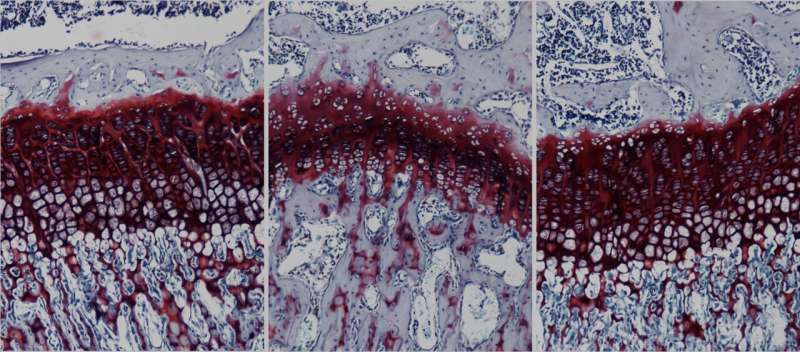Treatment with gene therapy of a new rat model of Morquio A

A research team from the Universitat Autònoma de Barcelona (UAB) has generated the first rat model recapitulating all disabling alterations experienced by patients with Mucopolysaccharidosis type IVA, also known as Morquio A disease. The team has developed a gene therapy that fully corrects the severe whole-body alterations in the rat model after a single intravenous viral vector administration. The research opens the door to a future therapy which could be administered at young ages in patients diagnosed with this rare disease, thereby preventing bone malformations, osteoarthritic complications and other life-threatening alterations.
Mucopolysaccharidosis type IVA, also known as Morquio A disease, is a rare disease caused by a deficiency of the GALNS enzyme, which causes alterations in bone growth (skeletal dysplasia), a rapid deterioration of cartilage and complications in the heart and trachea which result in cardiorespiratory complications that can cause premature death. The first symptoms are detected in very young children (about 2-year-old), and in the most severe cases, death generally occurs around 20 years of age. There is no cure for this disease and the current therapy, based on enzymatic replacement, cannot correct skeletal abnormalities.
Researchers at the UAB have generated the first rat model of Morquio A disease that fully reproduces the severity of the disease, in contrast to existing mouse models, especially skeletal dysplasia, early cartilage deterioration, and heart valves and trachea alterations, similarly to human patients. Using the CRISPR/Cas9 genome editing technology, the authors generated a rat carrying a mutation in the genome that causes the most frequent and severe form of this disease in humans.
Afterwards, the researchers developed the first gene therapy approach that reverted the whole plethora of pathological alterations of Morquio A disease in the new rat model. This gene therapy is based on the intravenous adminisitratation of a viral vector coding for the GALNS enzyme. The gene therapy mediated widespread biodistribution and ubiquitous expression of the therapeutic gene, particularly throughout the whole skeletal system. This allowed long-term production of the enzyme in all afflicted tissues, thus preventing alterations in bones, as well as in cartilage, trachea and heart.
“Administration of the gene therapy in four-weeks-old Morquio A rats completely reverted the clinical signs of the disease, such as bone growth alterations, dental malformations and fragility, articular cartilage pathology, and also the respiratory and cardiovascular complications,” explains Fatima Bosch, the UAB researcher and director of the study.
Presently, no gene therapy approach is being applied to treat Morquio A patients. This new therapy developed at the UAB results in sustained production of the enzyme throughout the body and particularly within the bones. Therefore, it could be used to treat children diagnosed with the disease at early ages, when the bone formation is very active and the skeletal alterations are not irreversible.
“The gene therapy developed by our team has the potential to correct the disabling Morquio A disease in humans. Nevertheless, studies investigating biodistribution and long-term safety of the therapeutic vector in large animals are required before moving the treatment to clinical phase,” Dr. Bosch concludes.
Joan Bertolin et al, Treatment of skeletal and non-skeletal alterations of Mucopolysaccharidosis type IVA by AAV-mediated gene therapy, Nature Communications (2021). DOI: 10.1038/s41467-021-25697-y
Citation:
Treatment with gene therapy of a new rat model of Morquio A (2021, September 10)
retrieved 10 September 2021
from https://phys.org/news/2021-09-treatment-gene-therapy-rat-morquio.html
This document is subject to copyright. Apart from any fair dealing for the purpose of private study or research, no
part may be reproduced without the written permission. The content is provided for information purposes only.
For all the latest Science News Click Here
For the latest news and updates, follow us on Google News.

